How many times have you heard — or even used — the excuse I’m getting too old for that?
It’s easy to buy into myths of diminishing function long before they become a reality. The problem is, once you stop challenging yourself, you start aging a whole lot faster.
Worse, as you lose muscle, agility, and balance, you run a much greater risk for health challenges and injuries that can markedly reduce your quality of life — and your satisfaction in living.
“For most people, functional longevity is what really matters. They don’t necessarily want to live to be 120, but they want to be able to do the things they need to do and like to do for as long as possible,” says Cody Sipe, PhD, cofounder and vice president of the Functional Aging Institute, which specializes in science-based training programs for older adults.
“When we look at functional aging, we think about all different domains: physical, social, cognitive, emotional, and mental. Exercise and physical activity really lie at the heart of all of these.”
So, what exercise prescription is most effective for helping people age well? Sipe prefers to take a holistic approach, building strength, endurance, energy, flexibility, and balance.
“As you get older, a lot of systems — including balance, coordination, power, and sensory — start to gradually decline, to the point where you can’t do the things you want to do,” says Sipe. Your training program needs to address each of these systems.
Regular cardiovascular exercise lowers the risk of many illnesses, and a 2014 study found that people with more muscle mass are likely to live longer.
Sipe also recommends high-intensity interval training, both to boost metabolism (which naturally slows with age) and to enhance cognitive functioning. A recent analysis of studies on exercise and cognition found that a combination of cardio and resistance training might be the most effective way to protect against degenerative brain changes associated with aging.
Sipe designed the following strength workout to help you get and stay optimally fit, regardless of your age. (If you’re in your 20s or 30s, pay attention to which exercises you find most challenging now and make them a priority.)
Here’s the takeaway: The better you can do something now, the better you’ll be able to do it when you’re older.
The All-Ages Workout
Trainer and workout designer Cody Sipe, PhD, suggests performing the following workout two or three days a week, with a minimum of 48 hours of recovery between workouts.
You can also incorporate these movements into your existing training program.
Workout Format
- Complete 12 repetitions of each exercise in a circuit format, resting as little as necessary between sets.
- Use the most challenging load you can handle while maintaining good form.
- Repeat the complete circuit (exercises 1 through 6) for a total of two or three rounds.
Equipment
- Knee-high chair or bench
- Resistance bands or cable-pulley machine
- Moderately heavy dumbbells
Tap and Squat
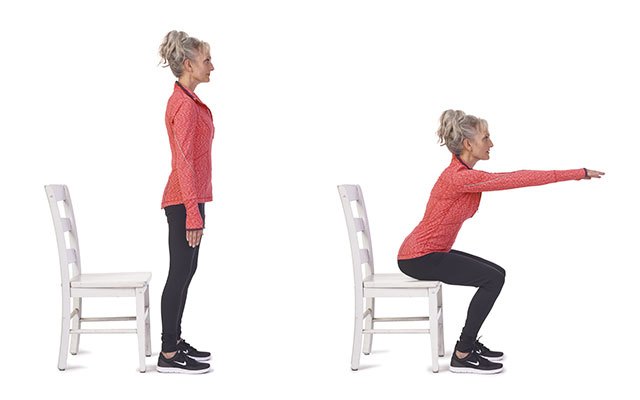
WHY: No exercise is more functional than squatting, and, in fact, rising from a seated position without using your hands for assistance is directly linked to longevity. This squat variation helps you stay powerful as you age.
HOW:
- Stand with feet at about hip width, directly in front of a chair or bench that is about knee height.
- Keeping your abs engaged, slowly push your hips backward and bend your knees until you feel your butt tap the chair.
- Drive your heels into the floor, squeeze your glutes, and rise as quickly as possible to a standing position.
- Repeat 12 times.
Make It Easier: Completely sit on the chair before rising to standing.
Make It Harder: Perform a jump right after you tap the chair. Land softly on the balls of your feet and sink back onto your heels.
Split-Stance One-Arm Row
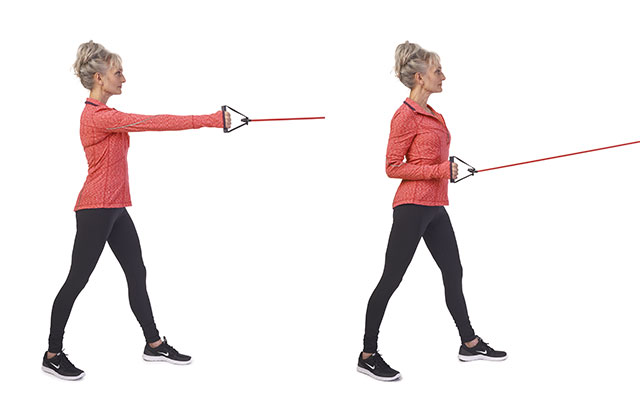
WHY: Rows strengthen your upper back and boost lower-back stability, improving posture and staving off aches, pains, and injury. Standing during this movement forces you to engage your core muscles to avoid rotating your trunk.
HOW:
- Grab the handle of a resistance band that’s attached to a secure anchor (or a cable-pulley machine) at shoulder height. Step backward to create tension. Hold the handle in your right hand with palm facing inward and arm extended. Take a step forward with your left foot.
- Keeping your abs engaged, pull the handle toward your body. Avoid rotating your torso and make sure to follow through so that you feel your right shoulder blade move toward your spine.
- Slowly extend your arm to the starting position.
- Perform 12 reps. Switch sides.
Make It Easier: Hold one handle in each hand and perform alternating rows.
Make It Harder: Step backward into a lunge as you initiate a single-arm row on the same side. Return the handle to the starting position as you step forward to complete the lunge.
Single-Leg Deadlift

WHY: This unilateral move builds serious glute strength while also challenging your core and balance.
HOW:
- Stand on your left foot with your weight in your heel and a soft bend in your knee.
- Hinge at the hips and allow your right leg to extend until it’s straight and parallel to the ground.
- Drive your heel into the floor and squeeze your left glute to return to starting position.
- Repeat 12 times. Switch sides.
Make It Easier: Practice balancing on one foot for up to 30 seconds.
Make It Harder: Hold a dumbbell or kettlebell for added resistance. Use the hand that gives you a greater sense of balance.
Pallof Press
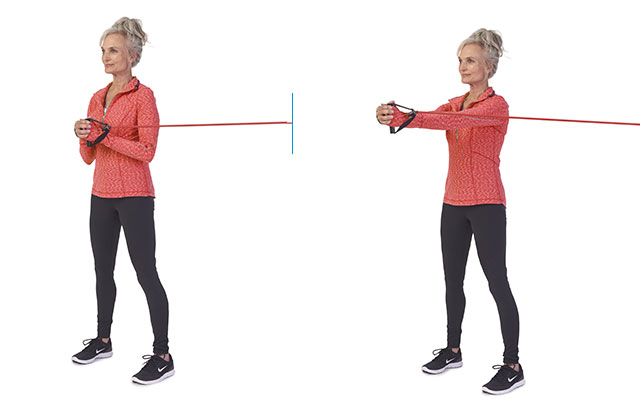
WHY: This move focuses on antirotation, in which you use your core to fight rotational forces, stabilizing and protecting the lumbar spine.
HOW:
- Grip the handle of a resistance band with both hands at your chest and step sideways until you feel slight tension in the band.
- Press the handle forward, avoiding rotation at your hips or shoulders. Hold for a moment.
- Return the handle to your chest.
- Perform 12 repetitions. Switch sides.
Make It Easier: Press the handle forward and hold for 10 seconds. Rest. Repeat five times.
Make It Harder: Add resistance, step farther away from the -anchor point, or perform the press while seated on the floor with legs extended in front of you.
Kneeling Shoulder Press
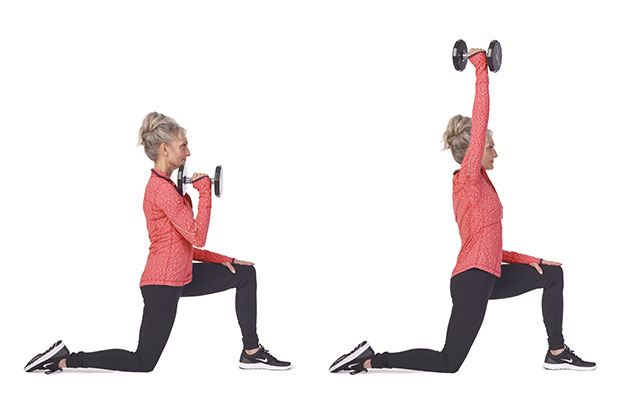
WHY: Performing this exercise with one arm and in an offset stance not only works your shoulders, but also challenges your core and hip stability.
HOW:
- Start in a kneeling lunge position with your left foot in front of you. Hold a dumbbell in your right hand at shoulder height.
- Engage your core, and press the weight overhead until your arm is fully extended.
- Slowly lower the weight to the starting position.
- Perform 12 repetitions. Switch sides.
Make It Easier: Substitute with single-arm lateral raises: Stand with a dumbbell at your side, and raise it, with palm facing down, to about shoulder height. Lower the weight, then repeat for 12 reps.
Make It Harder: Perform the press in a full kneeling position.
Bird Dog
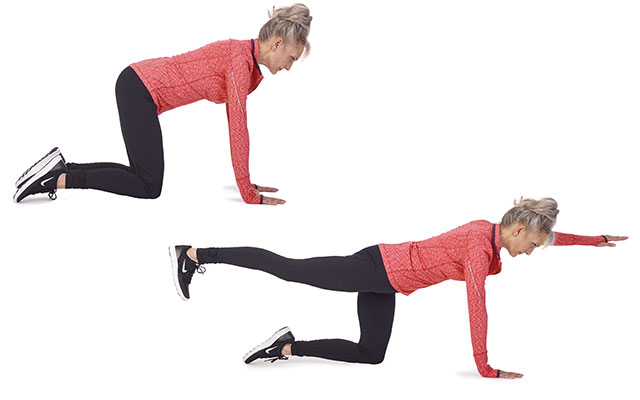
WHY: The Bird Dog challenges rotary stability, which means your core muscles stabilize your hips and spine while you move your arms and legs.
HOW:
- Start on your hands and knees. Simultaneously extend your left arm and right leg while keeping your abs engaged and maintaining a neutral spine (do not arch or round your back). Squeeze your right glute as you extend.
- Draw your elbow and knee back toward each other, aiming to tap them together.
- Perform 12 repetitions. Switch sides.
Make It Easier: Move your extended arm and leg out to the side slightly then back to a neutral position for each repetition.
Make It Harder: Extend your same-side arm and leg.
Split Stance One-Arm Chest Press
Why We Love It: Like the standing split-stance row, this version of a chest press requires greater core activation, resulting in more muscles worked and in a more real-life context than other chest exercises (think pushing open a heavy door).
- Grab the handle of a resistance band that’s attached to a secure anchor (or a cable-pulley machine) at shoulder height. Step backward to create tension.
- Turn your back to the anchor point. Hold the handle in your right hand to the right of your chest and take one step forward with your left foot.
- Keeping your abs engaged, push the handle forward, keeping it in line with your chest. Avoid rotating your torso.
- Slowly return the handle to the starting position.
- Perform 12 reps. Switch sides.
Make It Easier: Hold one handle in each hand and perform alternating, reciprocating chest presses. As one arm pushes forward, the other moves backward.
Make It Harder: Step forward into a lunge as you initiate a single-arm chest press. Return the handle to the starting position as you step backward to complete the lunge. Alternate lunging with your right and left leg until you complete 12 presses with one arm, then switch sides. Alternating legs while pressing with the same arm will add challenge your balance and core strength.
Standing Woodchop With Lateral Step
Why We Love It: This quick, rotational movement is effective for building core strength, power, and coordination.
- Start with a cable-pulley machine or resistance band attached to a secure anchor that is slightly above shoulder height.
- Grip the handle with two hands and take a few steps to the right of the anchor point. Stop when you feel tension.
- Stand with your feet at about hip width and abs engaged. Hold the handle just above your left shoulder.
- Step your right foot a couple of feet to the right, allowing your knee to bend without descending into a full lunge. Then quickly perform a chopping motion to bring the handle toward your right hip, rotating through your mid-back.
- In a controlled manner, return the handle to the starting position as you step back to the starting position. Repeat on your left side.
Make It Easier: Perform the chopping movement without the lateral step.
Make It Harder: Step into a lateral lunge as you perform each woodchop.
Warm-up: Balance, Agility, and Gait
Perform each exercise for 30 seconds in a circuit format. Repeat two times.
Carioca shuffle
- Quickly shuffle your feet to one side. Alternate crossing your trailing foot behind and in front of your lead foot. Switch directions. If this is too difficult, shuffle sideways without crossing your feet.
Hopscotch in place
- Alternate hopping from one foot to two feet, making sure to switch feet while in a single leg stance.
Line walk on toes
- Walk forward on a line, trying to stay up on your toes.
Learn the key moves to staying strong as you age by watching “The Workout: All Ages Strength Training (Video)“.
This article originally appeared as “All-Ages Strength Training” in the November 2015 issue of Experience Life.
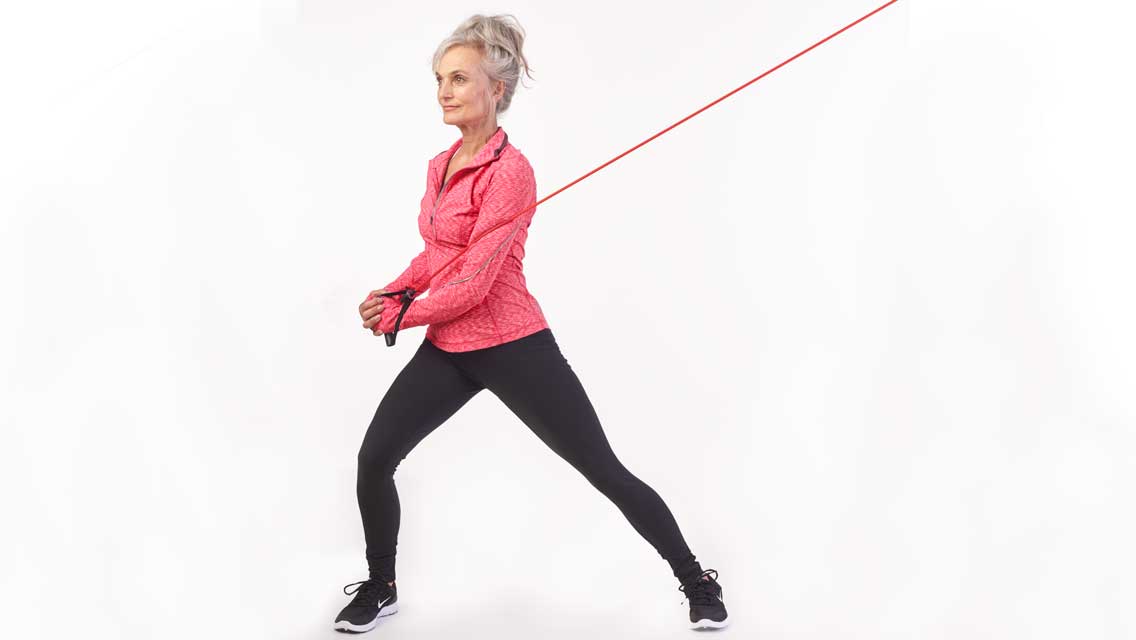
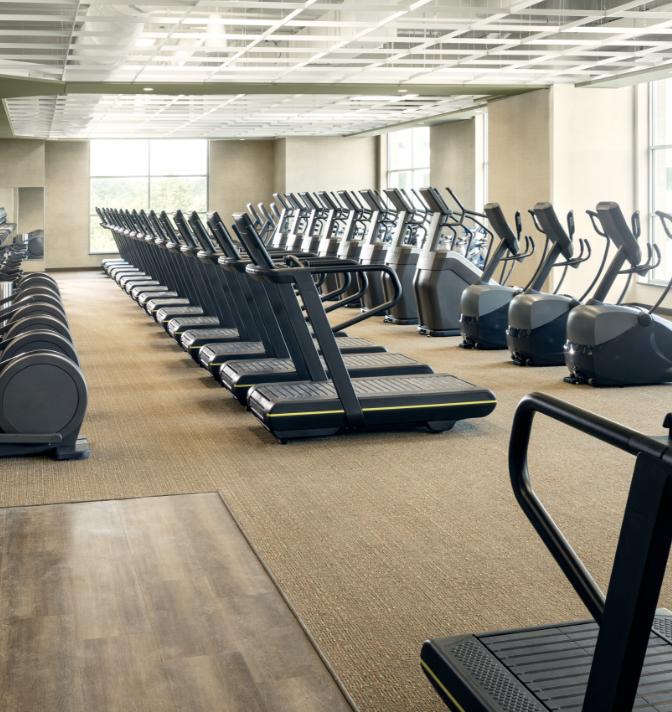



This Post Has One Comment
I’m 82 year old Woman and would like to know if you have any videos ? I walk 2 miles a day and do streching but would like to do more to improve muscle 😊